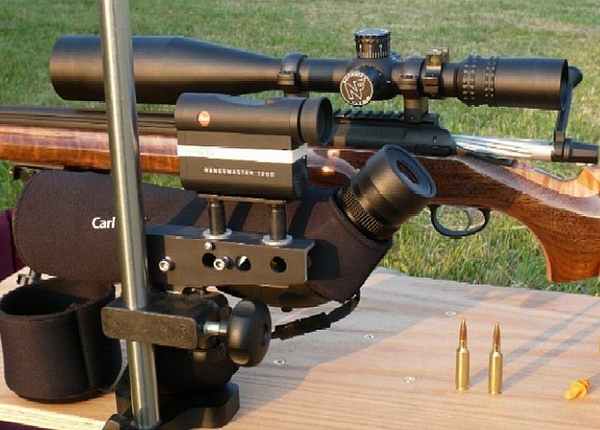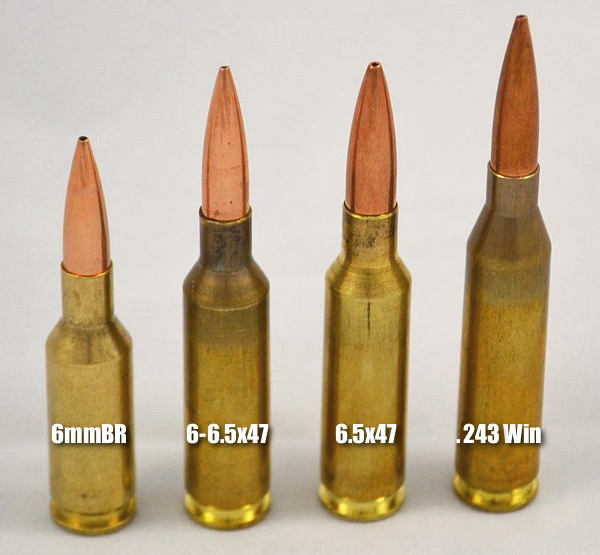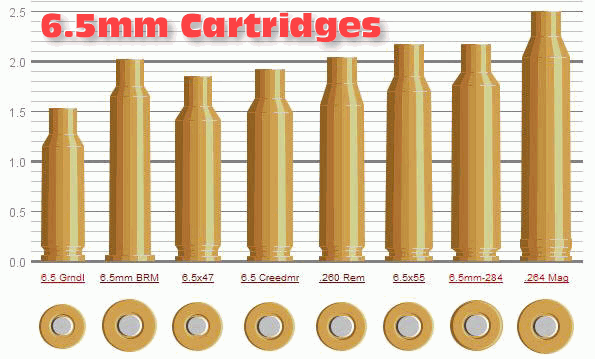After much anticipation, we finally rolled out our latest project gun, a Bat-actioned 6-6.5×47/6.5×47 Lapua switch-barrel benchrest rifle. Equipped with two (2) Bartlein 30″ 5R barrels, the gun was designed to compete in a variety of disciplines: F-Class, Varmint Matches (Silhouette + Paper), and 600- and 1000-yard Benchrest.
The gun was built to a 17-lb. weight limit, with the goal of achieving the maximum possible accuracy with this pair of cartridges. We chose two identical, 30″ Bartlein barrels so we could evaluate the relative performance of the 6.5×47 and its necked-down 6mm version, holding as many variables constant as possible. Both barrels were chambered by ace gunsmith Mark King with tight-tolerance, no-turn necks.
 .
.
Sightron provided the SIII 8-32×56 30mm scope, shown mounted in Burris Signature Zee Rings.
The rifle, two years in the making, features top-of-the-line components. The action is a BAT multi-flat MB, with a +20MOA Weaver-style rail on top. As the action was originally intended to be used in an F-Class rifle, the loading port was enlarged at the BAT factory to load full-length .284 Winchester rounds.
 The stock design is unique. It started as a Bruce Baer MB Tooley style, but we added some custom design upgrades. The sides of the fore-end are square (like a McMillan edge), and the underside of the fore-end has been relieved in the middle, creating two “rails”. The rear flat, on the underside of the buttstock, is 1.25″ wide, with a channel cut in the middle (to reduce drag, and to ensure that the bag tracks in the ears rather than on the center stitching.)
The stock design is unique. It started as a Bruce Baer MB Tooley style, but we added some custom design upgrades. The sides of the fore-end are square (like a McMillan edge), and the underside of the fore-end has been relieved in the middle, creating two “rails”. The rear flat, on the underside of the buttstock, is 1.25″ wide, with a channel cut in the middle (to reduce drag, and to ensure that the bag tracks in the ears rather than on the center stitching.)
The stock was expertly inletted, pillar-bedded, and finished by Alex Sitman of Master Class Stocks. Alex put much time and effort into ensuring that the geometry was square throughout, with straight, parallel tracking surfaces. The BAT MB action has an extended front section, to allow for additional bedding surface. The MB action employs a three-action screw design. Sitman installed pillars for all three action screws then carefully bedded the entire action. Alex, one of the best stock-workers in the world, did a great job on this rifle.

Rifle Will Provide Load Data for New Cartridge Guide
This rifle was originally conceived as a match-grade test bed for the 6.5×47 Lapua cartridge and its wildcat cousin the 6-6.5×47. Jason Baney will test different powders and bullets in the rifle, to develop reliable load data for an upcoming 6.5×47/6-6.5×47 Cartridge Guide. And yes, we will be trying H4350, Reloder 17, and the relatively new Hodgdon Hybrid 100V. Jason will test a variety of flat-base and boat-tail bullets in both 6mm and 6.5mm.
Pet Loads Wanted for 6-6.5×47 and 6.5×47 Cartridge Guide
While Jason will generate load data for our planned 6-6.5×47/6.5×47 Cartridge Guide, we recognize that one rifle (even with two barrels) can’t provide all the key info. Each gun has its powder/bullet preferences, so we want to offer a broad sampling of load data for the new Cartridge Guide. That’s where you, our readers, can help.
If you shoot the 6-6.5×47 or 6.5×47 Lapua, and have developed some really great loads, share them with us. We can then include more data in our planned load charts. Send your “pet loads” to mailbox@6mmBR.com. Be sure to include: Powder Brand, Charge Weight, Primer Type, Bullet Brand and weight, and the OAL or known seating depth. We also request that you list the type of action, barrel length, and contour. Chron data is also important. Include the tested Muzzle Velocity, Extreme Spread (ES), and Standard Deviation (SD) if possible. It’s helpful if you can provide a short summary of your load, such as “Great 600-yard accuracy, near max, works best with light neck tension, low ES/SD.”
Share the post "New Project Rifle — Our 6-6.5×47 + 6.5×47 Switch-Barrel"

 Our lead story on AccurateShooter.com this week features
Our lead story on AccurateShooter.com this week features 






 Frenchman Ties Perfect 600 Record Score
Frenchman Ties Perfect 600 Record Score


 After a lot of testing with different powder and bullet combos, I settled on 38.2 grains of Hodgdon Varget, with 130gr JLK bullets and CCI 450m primers. Velocity is 2914 fps. Seems that this is where it likes to be. In the photo below, you can see the results of a few different powders, but all with the fantastic JLK 130gr bullets. The 38.3 Varget load had all four rounds in nearly one hole and I pulled the fifth, so this was pretty much the load that I went with for my 600-yard Comp. The JLKs are really good, consistent bullets, and I think that the next barrel that I buy will be set up for these bullets and no other — they are that good. I seat the bullets at 2.157″ OAL, just kissing the lands. I could not go any further out as the bearing surface is short.
After a lot of testing with different powder and bullet combos, I settled on 38.2 grains of Hodgdon Varget, with 130gr JLK bullets and CCI 450m primers. Velocity is 2914 fps. Seems that this is where it likes to be. In the photo below, you can see the results of a few different powders, but all with the fantastic JLK 130gr bullets. The 38.3 Varget load had all four rounds in nearly one hole and I pulled the fifth, so this was pretty much the load that I went with for my 600-yard Comp. The JLKs are really good, consistent bullets, and I think that the next barrel that I buy will be set up for these bullets and no other — they are that good. I seat the bullets at 2.157″ OAL, just kissing the lands. I could not go any further out as the bearing surface is short.



 We ran a 6XC QuickLOAD simulation with 115gr bullets and H4350 powder. QuickLOAD predicted that the observed difference in case capacity can result in pressure differentials as much as 4,500 psi! In other words, if you switch from Norma 6XC brass to a lesser-capacity brass type, your pressures could rise 4,500 psi (using H4350 and 115gr bullets).
We ran a 6XC QuickLOAD simulation with 115gr bullets and H4350 powder. QuickLOAD predicted that the observed difference in case capacity can result in pressure differentials as much as 4,500 psi! In other words, if you switch from Norma 6XC brass to a lesser-capacity brass type, your pressures could rise 4,500 psi (using H4350 and 115gr bullets).
 6.5 Creedmoor vs. 6.5×47 Lapua — Cost Factor
6.5 Creedmoor vs. 6.5×47 Lapua — Cost Factor Hornady’s 6.5 Creedmoor loaded ammunition is also much less expensive than the loaded 6.5×47 Lapua rounds. For shooters that don’t have the time (or skills) to reload, the 6.5 Creedmoor (at
Hornady’s 6.5 Creedmoor loaded ammunition is also much less expensive than the loaded 6.5×47 Lapua rounds. For shooters that don’t have the time (or skills) to reload, the 6.5 Creedmoor (at 
 This video, produced for the folks at
This video, produced for the folks at 
 Norma 203B vs. Alliant Reloder 15
Norma 203B vs. Alliant Reloder 15









 The 6.5×55 case has 6 or 7% more capacity than the .260s, even more in practice when both are loaded to standard COALs with heavy bullets, which sees them having to seated very deep in the .260 Rem using up quite a lot of powder capacity. So loaded up for reasonable pressures in modern actions, the 6.5×55 will give a bit more performance.
The 6.5×55 case has 6 or 7% more capacity than the .260s, even more in practice when both are loaded to standard COALs with heavy bullets, which sees them having to seated very deep in the .260 Rem using up quite a lot of powder capacity. So loaded up for reasonable pressures in modern actions, the 6.5×55 will give a bit more performance. After Laurie’s helpful comments, some other Forum members added their insights on the .260 Rem vs. 6.5×55 question:
After Laurie’s helpful comments, some other Forum members added their insights on the .260 Rem vs. 6.5×55 question:
 6.5×47 Lapua Cartridge Guide Highlights:
6.5×47 Lapua Cartridge Guide Highlights:











 At this year’s Silhouette Championship, Team Lapua shooters Cathy Winstead-Severin and Mark Pharr finished first and second overall. The match went down to the wire, with Cathy edging out Mark in a shoot-off for the overall title. Earlier in the competition, Cathy set a new Woman’s National Record in a 120-shot course with a stunning 97/120, breaking the previous record of 90 by seven points. Another record was broken by the Hunter Rifle Team of Cathy Winstead-Severin, Mark Pharr, and Mallory Nichols. This talented Team Lapua threesome set a new national record of 295, besting the mark set in 2004. Team Lapua also took second place in the Standard Rifle Team Division.
At this year’s Silhouette Championship, Team Lapua shooters Cathy Winstead-Severin and Mark Pharr finished first and second overall. The match went down to the wire, with Cathy edging out Mark in a shoot-off for the overall title. Earlier in the competition, Cathy set a new Woman’s National Record in a 120-shot course with a stunning 97/120, breaking the previous record of 90 by seven points. Another record was broken by the Hunter Rifle Team of Cathy Winstead-Severin, Mark Pharr, and Mallory Nichols. This talented Team Lapua threesome set a new national record of 295, besting the mark set in 2004. Team Lapua also took second place in the Standard Rifle Team Division.






 6.5mm Creedmoor – Developed by Hornady and Creedmoor Sports, the 6.5mm Creedmoor is designed for efficiency and function. Its shape reaches high velocities while maintaining standard .308 Winchester pressures and its overall length fits well with .308 Win length magazines. You can expect velocities of 2600-2700+ fps with 140gr bullets.
6.5mm Creedmoor – Developed by Hornady and Creedmoor Sports, the 6.5mm Creedmoor is designed for efficiency and function. Its shape reaches high velocities while maintaining standard .308 Winchester pressures and its overall length fits well with .308 Win length magazines. You can expect velocities of 2600-2700+ fps with 140gr bullets.